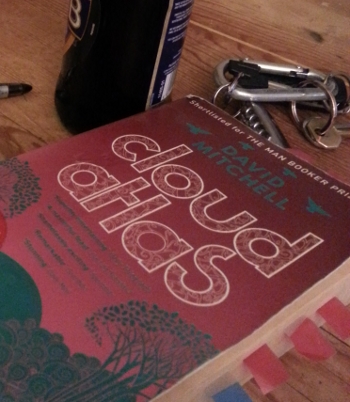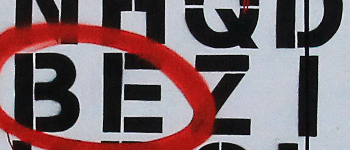 The stories of Cloud Atlas are accessibly written. They are, to use a pejorative term, readable. Each is a complete, albeit interrupted, tale and can be read as a relatively simple plot-driven narrative. A man is slowly poisoned by his deceitful doctor. A composer leaves home and is destroyed by the birth of his own masterwork. A young reporter uncovers a murderous conspiracy. And so on. Even at this level, each story is explicitly something told. It’s a diary, or a set of letters, a memoir, a deposition, or a fireside yarn. The one omniscient third person narrative is carefully situated as a story written within the frame of the novel, and ascribed a fictional author. Even reading it ‘straight’ we are aware that this is a tale told by Hilary V. Hush. The layer of mediation, the teller of the tale, remains. This is always the case, of course.
The stories of Cloud Atlas are accessibly written. They are, to use a pejorative term, readable. Each is a complete, albeit interrupted, tale and can be read as a relatively simple plot-driven narrative. A man is slowly poisoned by his deceitful doctor. A composer leaves home and is destroyed by the birth of his own masterwork. A young reporter uncovers a murderous conspiracy. And so on. Even at this level, each story is explicitly something told. It’s a diary, or a set of letters, a memoir, a deposition, or a fireside yarn. The one omniscient third person narrative is carefully situated as a story written within the frame of the novel, and ascribed a fictional author. Even reading it ‘straight’ we are aware that this is a tale told by Hilary V. Hush. The layer of mediation, the teller of the tale, remains. This is always the case, of course.
This is a novel in which telling is a problem. Adam Ewing worries that his diary will be discovered, Frobisher worries too about his letter’s discovery, and a nosy postmaster. Elsewhere Sonmi~451 is introduced to her orison and the rules of discourse are negotiated. Timothy Cavendish inks his memoir in longhand. He disapproves of ‘backflashes, foreshadowings and tricksy devices’ None of these narratives allow the reader simply to bathe in an evoked ‘reality’ since she is constantly reminded of the tales’ fictional tellers.
The stories also exist in explicit relation to popular and historical genres including dystopian science fiction, airport crime novel, the 19th century sea adventure, and so on. These relationships run deeper than glancing reference. They shade somewhere between pastiche and homage. Many specific novels are also referenced as we shall see.
‘Half Lives — The First Luisa Rey Mystery’, is written in the third person in a sharp present tense. The narrator hovers close to a point of view character’s perspective for most scenes, but wavers occasionally, hopping heads, or sitting like a camera on the wrong side of a door about to open. The chapters are short. Characters tend to fall into types: the sassy protagonist, the match-making mother, gruff rough diamonds, and black-hearted villains. The descriptions are terse and efficient.
Wednesday morning is smog-scorched and heat-hammered, like the last hundred mornings and the next fifty.
This is writing with a put-on accent. It owes debts to Hammett and Chandler via Sara Paretsky and James Patterson.
‘An Orison of Sonmi~451’ also references genre sources. Its themes include corporatist government, ecological disaster, cloning, and social control through leisure and entertainment. These explicitly conjure science fiction tropes epitomised by various movies and books including Brave New World by Aldous Huxley, 1984 by George Orwell, Blade Runner (which in turn is based on Do Androids Dream of Electric Sheep by Philip K Dick), Jennifer Government by Max Barry, The Sheep Look Up by John Brunner, Soylent Green (based on Make Room! Make Room! by Harry Harrison) and many more. In particular, of course, the story’s name references Fahrenheit 451 by Ray Bradbury, another dystopian fantasy which portrays a world in which reading has been outlawed and moronic mass entertainment helps control a drugged population. Even a reader with no background in science fiction will recognise a few of these influences, and cannot but read the story with reference to them.
So there is a quoted element to the stories in Cloud Atlas. We must read them with an awareness that these texts are more than simply windows onto a world, or a set of worlds. Each story is constrained by, or at least relates to, sets of literary conventions that we recognise, and know determine the nature of the worlds portrayed.
Cloud Atlas is structured so that each tale wraps another, giving way to, and only concluding after, its successor. Each parent tale wraps its child. Then, within the child story, part of the parent text is found and read. Here is another point at which form is foregrounded, made explicit. Each new reader provides an assessment of the previous text, calling upon us to re-engage with each preceding narrative. So Frobisher is unsure about Adam Ewing’s narrative:
Something shitfy about the journal’s authenticity–seems too structured for a genuine diary, and its language doesn’t ring quite true…
Then, the doubly-fictional Luisa Rey discovers Frobisher’s letters, and is troubled by the “dizzying vividness of the images of places and people that the letters have unlocked.”
Then Timothy Cavendish receives an unsolicited manuscript of Half Lives which, he says “would be a better book if it weren’t so artsily-fartsily Clever”.
‘Nutcase ahoy’, he says when he reads the covering letter by a ‘lady author, one dubiously named Hilary V. Hush’. Both the comic overtones of the name with its implication of pseudonym (and sexual ambiguity) and Cavendish’s doubts underline the constructed nature of the story. The fictional author of a fiction within a fiction, is herself doubted, and even further fictionalised when Cavendish fantasises about her.
And so on…
So the role of these stories as stories is highlighted on at least three levels. Firstly within each story by emphasising the mode of telling. Secondly, in the way that the stories identify themselves as stories in relation to genre conventions. Thirdly, in the way the stories reference one one another as texts.
The referentiality within Cloud Atlas is so layered that it is hard to stay on topic when following any one thread of reference. This is, in part, because the nature of the novel makes internal, as well external, references intertextual. Cavendish’s single cry “Soylent Green is people!” ties in a cannibalism theme, a reference to genre, a reference to a novel, a reference to a movie, and a reference between stories — all on its own. The fact that Cavendish’s tale is ultimately consumed not in its presented form but as a movie also resonates here.
Cloud Atlas emphasises the fact that it exists as a collection of texts by first splitting them up and then joining them back together. Much of the referentiality within Cloud Atlas, therefore is internal. This creates a mechanism of the story, a system, reminiscent of the closed system of Catch 22, and of the figure 8 in Tom McCarthy’s Remainder.
Within the narratives, the obvious points of relation between the stories can be found at the moments at which the characters consume the tales of their predecessors. As we have seen, these moments are often accompanied by doubts or criticisms that call authorship into question. These are moments of transmission. Whatever the truth of the comet birthmark each character hands off both doubt and knowledge to the next. The uneasy resonance of each story for the consumer binds the structure together. At the same time the character’s explicit doubt emphasises artifice. By questioning the provenance of the preceding text, for example, Frobisher, challenges the frame and he ushers in Mitchell the author.
There’s much fun to be had with explicit references between the tales. Ayrs dreams of Somni’s servery– a ‘nighmarish cafe’ where the ‘waitresses all had the same face’. Cavendish, is mis-sold tickets by ‘stem-cell twins’ and is served slop by a ‘sexless automaton’. He also, of course, sings out his line about Soylent Green, and encounters a Sikh taxi driver who says: “Sick teen-squid Zachary”.
This last, apart from being an absolutely appalling pun, is interesting because it illustrates yet another instance of double think or double-focus. On the one hand these references across stories bring the novel together, they support a thesis of interconnectedness. We are tempted to use them to construct a theory, a plausible model of the universe. On the other hand, Mitchell-the-author is clearly winking at the reader over the heads of his characters here (as he does with the title for Luisa Rey’s story: Half Lives and any number of other nudges).
Less flippantly, the central themes of Cloud Atlas appear everywhere–in symbols, asides, tableaux of plot. Everywhere we see power and submission. Alberto Grimaldi, Somni~451, and Morty Dhondt all ruminate on the will to power, as does Doctor Goose in his own way. Kapuka and the Maori teach the same lesson with murder and rape. Nea So Copros subjugates its clones and its ‘downstrata’ citizens.
The powerful feast, sometimes literally, on the weak. “Soylent Green is People!”, wails Timothy Cavendish once again. And of course, it turns out in Somni’s tale that Soap, the food of clones is in fact made of people. Goose, who is found in the opening scene collecting teeth in a ‘cannibal’s banqueting hall’ is a vampire, thinks Frobisher. His first Law of Survival is ‘The Weak are Meat the Strong do Eat’
Despoilation too is everywhere. Western hunters deplete the seal population of Rēkohu 14. The Swannekke B plant threatens ecological disaster, The corpocracy of Nea So Copros is fighting a losing battle against the encroaching badlands, and Zachry lives in a world on the other side of ruin.
And always, there is circularity.
The characters are bound up in a complex and strange machine, one in which the parts don’t quite fit. ‘We cross, crisscross and recross our old tracks like figure skaters’ says Timothy Cavendish. The sense that everything will repeat, or that souls reincarnate pervades. There is a conceit that the story’s protagonists are somehow instances of the same spirit. They are, most obviously bound together by the presence of the comet birthmark, but also by their premonitions of one another’s lives, or maybe of future possible versions of their own lives.
Frobisher reads Nietzche’s Thus Spake Zarathustra, and Ayrs plans a symphony to be named Eternal Recurrence. The minor-league rock musician in Luisa’s story has a guru on his last reincarnation. Stoned and stuck on a roundabout, Cavendish hears a song ‘about how everything that dies someday comes back’, and Frobisher finally comforts Sixsmith with the prospect of rebirth: ‘We do not stay dead long’.
Of course the nature of the circularity in Cloud Atlas is predictably unclear. In one sense the structure of the novel is itself a cycle. It almost ends where it begins, with the strong preying on the weak, and an ineffectual representative of a complicit ‘civilisation’ on the sidelines. But the cycle is also embedded in images of reincarnation, and the replaying of history.
In fact Cloud Atlas leads us almost all the way to grand theory, the ultimate realist alibi of a plausible explainable system. But the novel remains disconnected, and un-join-uppable (to the evident disappointment of some readers). The largest clue to this is Luisa’s story which is fictional within the novel and so sits at an odd angle to any clean theory of transmission. The probable temporal overlap between Luisa and Cavendish is also a problem here, as is the mystical appearance of the comet on Somni’s birthmark-resistant body.
Although Cloud Atlas resists joining up, and even though no single material world can be seen through the lenses of its broken stories, it still offers a remarkably singular moral vision of the world, and in this it’s very much in the realist tradition. There is no doubt about where the good lies in these tales, or the bad, and on whose side we’re meant to be, despite Ewing’s cry that there are ‘as many truths as men’). And in his appeal at the end, we move from a fractured amoral world, to a more comfortable ordered moral universe.
In Cloud Atlas it seems that experimentalist elements win out over the realist. Despite its many hints, it resists explanation, it uses its referentiality to emphasise its own artifice. In their liberal referencing of, even pastiche of, popular genre, the stories distance the reader from any sense of a reflected world. In these senses, Cloud Atlas is unresolvable.
For all its playfulness, though, for all its resistance to unquestioned mimesis, Cloud Atlas presents, and arguably pretends to reflect, an ordered moral universe, and a vision of continuity. The comet-self persists from story to story, and the struggle plays out in the same patterns. While Italo Calvino’s If on a Winter’s Night a Traveller (an acknowledged influence) created an open system, a system of starts without ends, Mitchell smooths things over. He closes the wounds.




